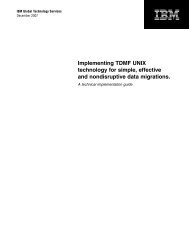Big Green: IBM and the ROI of Environmental Leadership
Big Green: IBM and the ROI of Environmental Leadership
Big Green: IBM and the ROI of Environmental Leadership
Create successful ePaper yourself
Turn your PDF publications into a flip-book with our unique Google optimized e-Paper software.
Early impacts <strong>of</strong> this program were on <strong>the</strong> company’s packaging. <strong>IBM</strong> made <strong>the</strong><br />
move to st<strong>and</strong>ard corrugated boxes <strong>and</strong> required greater recycled content. In 2000, it<br />
established a database to capture <strong>the</strong> cost savings <strong>of</strong> its various packaging initiatives.<br />
In <strong>the</strong> last five years, <strong>the</strong> company has realized over $80M in savings while reducing<br />
<strong>the</strong> environmental impact <strong>of</strong> its packaging. More recently <strong>the</strong>se design for environment<br />
processes <strong>and</strong> IT tools have enabled <strong>IBM</strong> to report <strong>the</strong> compliance status <strong>of</strong> assemblies<br />
or full systems against regulations such as <strong>the</strong> European Reduction <strong>of</strong> Hazardous<br />
Substances (RoHS) requirements.<br />
Design for recycling<br />
In its global operations, <strong>IBM</strong> was an early leader in solid waste recycling. In<br />
1988, <strong>IBM</strong> set a goal <strong>of</strong> recycling 50% <strong>of</strong> all wood, metal, paper, glass, <strong>and</strong><br />
plastic from its manufacturing sites by 1992 (by 1990 <strong>the</strong> worldwide figure<br />
was 52%). <strong>IBM</strong> has since updated its nonhazardous waste recycling goal.<br />
Currently, <strong>the</strong> company’s goal is to recycle 67% <strong>of</strong> <strong>the</strong> nonhazardous waste<br />
generated by locations owned or operated by <strong>IBM</strong>. In 2005, <strong>the</strong> last year <strong>the</strong><br />
data was compiled, <strong>IBM</strong> recycled 77% <strong>of</strong> its nonhazardous waste.<br />
Its experience with recycling programs throughout <strong>the</strong> organization made<br />
it easier for design engineers to think about how to embed those same<br />
principles into <strong>the</strong> product development process. In 1991, <strong>IBM</strong> established<br />
<strong>the</strong> Engineering Center for <strong>Environmental</strong>ly Conscious Products (ECECP) in<br />
North Carolina.<br />
As far back as <strong>the</strong> PS/2 Model 40 in 1991, <strong>IBM</strong> designed products based on a “design<br />
for disassembly” strategy that made manufacturing as well as disassembly much easier<br />
through <strong>the</strong> use <strong>of</strong> snap technology. At <strong>the</strong> same time, with <strong>the</strong> PS/2 E, <strong>the</strong> company<br />
was able to recover plastic covers from end-<strong>of</strong>-life computers <strong>and</strong> blend <strong>the</strong> recaptured<br />
plastic to make PS/2 covers with 25% recycled content. By 2006, 28% <strong>of</strong> all plastic<br />
resins procured by <strong>IBM</strong> contain recycled plastic content.<br />
“Maintain respect for<br />
natural resources by<br />
practicing conservation<br />
<strong>and</strong> striving to recycle<br />
materials, purchase<br />
recycled materials, <strong>and</strong><br />
use recyclable packaging<br />
<strong>and</strong> o<strong>the</strong>r materials.”<br />
—Corporate Policy 139<br />
AMR Research Report | April 2007 © AMR Research, Inc.

















